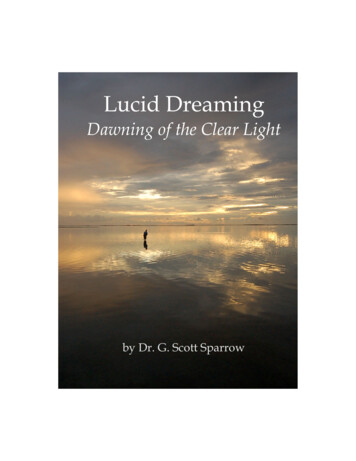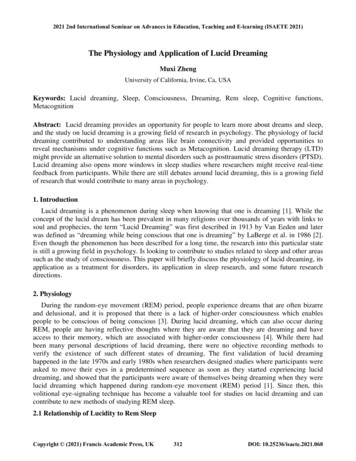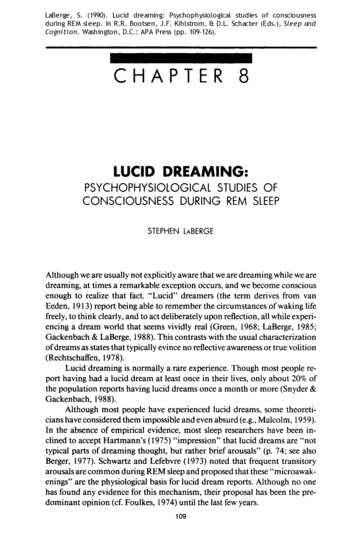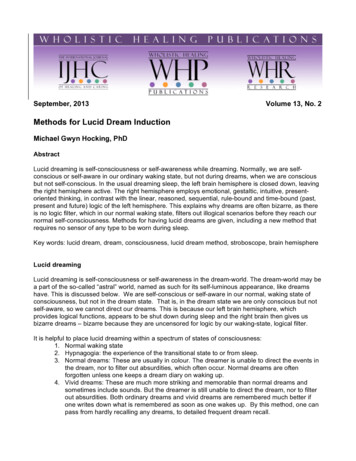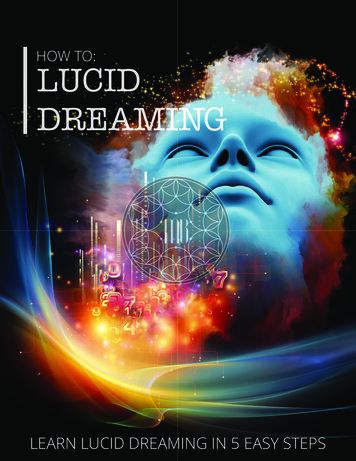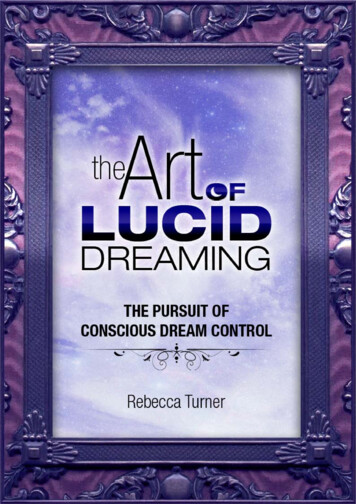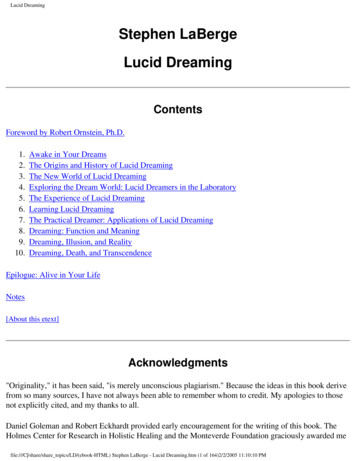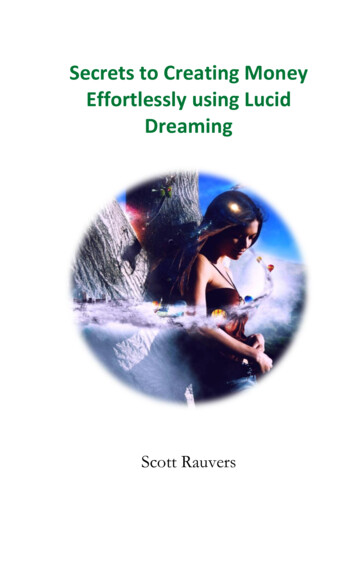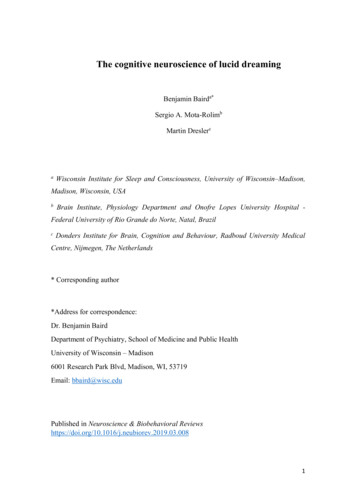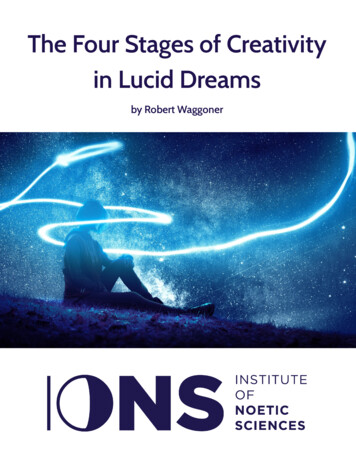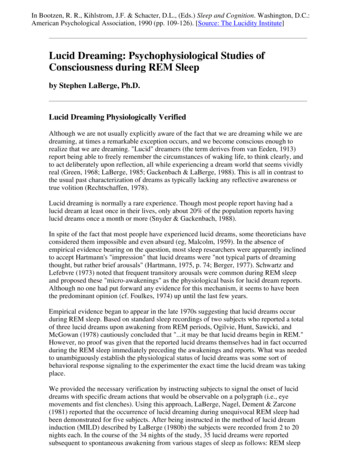
Transcription
In Bootzen, R. R., Kihlstrom, J.F. & Schacter, D.L., (Eds.) Sleep and Cognition. Washington, D.C.:American Psychological Association, 1990 (pp. 109-126). [Source: The Lucidity Institute]Lucid Dreaming: Psychophysiological Studies ofConsciousness during REM Sleepby Stephen LaBerge, Ph.D.Lucid Dreaming Physiologically VerifiedAlthough we are not usually explicitly aware of the fact that we are dreaming while we aredreaming, at times a remarkable exception occurs, and we become conscious enough torealize that we are dreaming. "Lucid" dreamers (the term derives from van Eeden, 1913)report being able to freely remember the circumstances of waking life, to think clearly, andto act deliberately upon reflection, all while experiencing a dream world that seems vividlyreal (Green, 1968; LaBerge, 1985; Gackenbach & LaBerge, 1988). This is all in contrast tothe usual past characterization of dreams as typically lacking any reflective awareness ortrue volition (Rechtschaffen, 1978).Lucid dreaming is normally a rare experience. Though most people report having had alucid dream at least once in their lives, only about 20% of the population reports havinglucid dreams once a month or more (Snyder & Gackenbach, 1988).In spite of the fact that most people have experienced lucid dreams, some theoreticians haveconsidered them impossible and even absurd (eg, Malcolm, 1959). In the absence ofempirical evidence bearing on the question, most sleep researchers were apparently inclinedto accept Hartmann's "impression" that lucid dreams were "not typical parts of dreamingthought, but rather brief arousals" (Hartmann, 1975, p. 74; Berger, 1977). Schwartz andLefebvre (1973) noted that frequent transitory arousals were common during REM sleepand proposed these "micro-awakenings" as the physiological basis for lucid dream reports.Although no one had put forward any evidence for this mechanism, it seems to have beenthe predominant opinion (cf. Foulkes, 1974) up until the last few years.Empirical evidence began to appear in the late 1970s suggesting that lucid dreams occurduring REM sleep. Based on standard sleep recordings of two subjects who reported a totalof three lucid dreams upon awakening from REM periods, Ogilvie, Hunt, Sawicki, andMcGowan (1978) cautiously concluded that ".it may be that lucid dreams begin in REM."However, no proof was given that the reported lucid dreams themselves had in fact occurredduring the REM sleep immediately preceding the awakenings and reports. What was neededto unambiguously establish the physiological status of lucid dreams was some sort ofbehavioral response signaling to the experimenter the exact time the lucid dream was takingplace.We provided the necessary verification by instructing subjects to signal the onset of luciddreams with specific dream actions that would be observable on a polygraph (i.e., eyemovements and fist clenches). Using this approach, LaBerge, Nagel, Dement & Zarcone(1981) reported that the occurrence of lucid dreaming during unequivocal REM sleep hadbeen demonstrated for five subjects. After being instructed in the method of lucid dreaminduction (MILD) described by LaBerge (1980b) the subjects were recorded from 2 to 20nights each. In the course of the 34 nights of the study, 35 lucid dreams were reportedsubsequent to spontaneous awakening from various stages of sleep as follows: REM sleep
32 times, NREM Stage-1, twice, and during the transition from NREM Stage-2 to REM,once. The subjects reported signaling during 30 of these lucid dreams. After each recording,the reports mentioning signals were submitted along with the respective polysomnograms toa judge uninformed of the times of the reports. In 24 cases (90%), the judge was able toselect the appropriate 30 second epoch on the basis of correspondence between reported andobserved signals. All signals associated with lucid dream reports occurred during epochs ofunambiguous REM sleep scored according to the conventional criteria (Rechtschaffen &Kales, 1968).A later analysis extending these data with two additional subjects and 20 more lucid dreamsproduced identical results (LaBerge, Nagel, Taylor, Dement, & Zarcone, 1981). LaBerge etal. argued that their investigations demonstrated that lucid dreaming usually (thoughperhaps not exclusively) occurs during REM sleep. This conclusion is supported byresearch carried out in several other laboratories (Dane, 1984; Fenwick et al., 1984; Hearne,1978; Ogilvie, Hunt, Kushniruk, & Newman, 1983).Ogilvie et al. (1983) reported the physiological state preceding 14 spontaneous luciditysignals as unqualified REM in 12 (86%) of the cases; of the remaining two cases, one was"ambiguous" REM and the other appeared to be wakefulness. Keith Hearne and AlanWorsley collaborated on a pioneering study of lucid dreaming in which the latter spent 50nonconsecutive nights in the Hull University sleep lab while the former monitored thepolygraph. Worsley reported signaling in 8 lucid dreams, all of which were described byHearne (1978) as having occurred during REM sleep.However, demonstrations that signaling of lucid dreams occurs during REM sleep raisesanother kind of question: What exactly do we mean by the assertion that lucid dreamers are'asleep?' Perhaps these 'dreamers' are not really dreamers, as some argued in the lastcentury; or perhaps this 'sleep' is not really sleep, as some have argued in this century. Howdo we know that lucid dreamers are 'really asleep' when they signal? If we considerperception of the external world as a criterion of being awake (to the external world), wecan conclude that they are actually asleep (to the external world) because although theyknow they are in the laboratory, this knowledge is a matter of memory, not perception.Upon awakening, they report having been totally in the dream world and not in sensorycontact with the external world.It might be objected that lucid dreamers might simply not be attending to the environment;rather than being asleep, perhaps they are merely absorbed in their private fantasy worldsas, for example, when deeply immersed in a novel or daydream. However, according to thereports of lucid dreamers (LaBerge, 1980a, 1985), if they deliberately attempt to feel thebedcovers they know they are sleeping in or try to hear the ticking of the clock they know isbeside their bed, they fail to feel or hear anything except what they find in their dreamworlds. Lucid dreamers are conscious of the absence of sensory input from the externalworld; therefore, on empirical grounds, they conclude that they are asleep.If, in a contrary case, subjects were to claim to have been awake while showingphysiological signs of sleep, or vice versa, we might have cause to doubt their subjectivereports. However, when -- as in the present case -- the subjective accounts and objectivephysiological measures are in clear agreement, it is embarrassingly awkward to assert (assome critics have done) that subjects who reported being certain that they were asleep whileshowing physiological indications of unequivocal sleep were actually awake (cf. LaBerge,Nagel, Dement & Zarcone, 1981).Some critics have suggested that "demand characteristics" might account for our results. Itis true that our subjects were under demand to have, signal and report lucid dreams, but howcould demand alone account for them doing all three things without having been lucid in thefirst place? If they merely unconsiously signaled, we would have found REM periods with
signals without subsequent reports of lucidity -- but we did not. If they merely reportedhaving signaled without actually having done so, we would have found reports withoutsignals, which we did not. Further, by this account, where would the reported and observedsignals have come from?The evidence is clear: lucid dreaming is an experiential and physiological reality; thoughperhaps paradoxical, it is clearly a phenomenon of sleep.Physiological Characteristics Of Lucid DreamingThe preceding studies have shown that lucid dreams typically occur in REM sleep.However, since REM sleep is a heterogeneous state exhibiting considerable variations inphysiological activity, of which two distinct phases are ordinarily distinguished. In its mostactive form, REM is dominated by a striking variety of irregular and short-lived events suchas muscular twitching, including the rapid eye movements that give the state one of its mostcommon names. This variety of REM is referred to as 'phasic,' while the relatively quiescentstate remaining when rapid eye movements and other phasic events temporarily subside isreferred to as 'tonic.' On first thought, one might expect lucid dreams to be associated withdecreased phasic activity (Pivik, 1986). However, research by the Stanford group, detailedbelow, has shown lucid dreaming to be associated with, on the contrary, increased phasicactivity.LaBerge, Levitan, and Dement (1986) analyzed physiological data from 76 signal-verifiedlucid dreams (SVLDs) of 13 subjects. The polysomnograms corresponding to each of theSVLDs were scored for sleep stages and every SVLD REM period was divided into 30 sepochs aligned with the lucidity onset signal. For each epoch, sleep stage was scored andrapid eye movements (EM) were counted; if scalp skin-potential responses were observableas artifacts in the EEG, these were also counted (SP). Heart rate (HR) and respiration rate(RR) were determined for SVLDs recorded with these measures.For the first lucid epoch, beginning with the initiation of the signal, the sleep stage wasunequivocal REM in 70 cases (92%). The remaining six SVLDs were less than 30 s longand hence technically unscorable "by the book" (Rechtschaffen & Kales, 1968). For thesecases, the entire SVLD was scored as a single epoch; with this modification, all SVLDsqualified as REM. The lucid dream signals were followed by an average of 115 s (range: 5to 490 s) of uninterrupted REM sleep. Physiological comparison of EM, HR, RR, and SPfor lucid vs. non-lucid epochs revealed that the lucid epochs of the SVLD REM periods hadsignificantly higher levels of physiological activation than the preceding epochs of nonlucid REM from the same REM period. Similarly, H-reflex amplitude is lower during lucidcompared to non-lucid REM (Brylowski, Levitan, & LaBerge, 1989).In order to study the temporal variations of physiology as they correlated with thedevelopment and initiation of lucidity, for each SVLD REM period the physiologicalvariables were converted to standard scores and averaged across dreams and subjects.Figure 1 is a histogram of the resultant mean standard scores for the five minutes before andthe five minutes after the initiation of lucidity. Note the highly significant increases inphysiological activation during the 30 s before and after lucidity onset.
Figure 1. Histograms of grand mean z-scores for EM, RR, HR, and SP.Bins are 30 s in lengthwith t 0 representing the signaled onset of lucidity. Ns vary with variable and bin, but allvalues are averaged across lucid dreams and subjects. (* p .05)Physiological data (EM, RR, HR, and SP) were also collected for sixty-one control nonlucid REM periods, derived from the same 13 subjects, in order to allow comparison withSVLDs. Mean values for EM and SP were significantly higher for REM periods with luciddreams than non-lucid control REM periods (RR and HR did not differ).Given the finding that lucid dreams reliably occur during activated (phasic) REM, measuresof central nervous system activation, such as eye movement density, should contributesomething to the pattern of lucid dream distribution. Since it had been previously observedthat eye-movement density starts at a low level at the beginning of REM periods andincreases until it reaches a peak after approximately five to seven minutes (Aserinsky,1971), we (LaBerge et al., 1986) hypothesized that lucid dream probability should follow aparallel development and accordingly found that mean eye-movement density correlatedpositively and significantly with lucid dream probability (r .66, p .01).Lucid dreams have been frequently reported to occur most commonly late in the sleep cycle(Green, 1968). LaBerge et al. (1986) tested this hypothesis by first determining for each oftheir 12 subjects the time of night which divided their total REM time into two equal parts.All but one of the subjects had more lucid dreams in the second half of their REM time thanin the first half (binomial test; p .01). For the combined sample, relative lucidityprobability was calculated for REM periods one through six of the night by dividing thetotal number of lucid dreams observed in a given REM period by the corresponding totaltime in stage REM for the same REM period. A regression analysis clearly demonstratedthat relative lucidity probability was a linear function of ordinal REM period number (r .98, p .0001).There are two distinct ways in which lucid dreams are initiated. In the usual case, subjectsreport having been in the midst of a dream when a bizarre occurrence causes sufficientreflection to yield the realization that they are dreaming. In the other, less frequent case,subjects report having briefly awakened from a dream and then falling back asleep directlyentering the dream with no (or very little) break in consciousness (Green, 1968; LaBerge1985a). Here is an example of a wake-initiated lucid dream:I was lying awake in bed late in the morning listening to the sound of runningwater in the adjoining bathroom. Presently an image of the ocean appeared, dim
at first like my usual waking imagery. But its vividness rapidly increased while,at the same time, the sound of running water diminished; the intensity of theinternal image and external sound seemed to alter inversely (as if one changeda stereo balance control from one channel to the other). In a few seconds, Ifound myself at the seashore standing between my mother and a girl whoseemed somehow familiar. I could no longer hear the sound of the bath water,but only the roar of the dream sea. (LaBerge, 1980, p. 85)Note that the subject is continuously conscious during the transition from wakefulness tosleep. This fact suggests that Foulkes (1985) is over-stating the case by claiming that it is".a necessary part of the experience we call 'sleep' that we lose a directive and reflectiveself. You can't fall asleep, or be asleep, if your waking self is still regulating and reflectingupon your conscious mental state" (p. 42).Since lucid dreams initiated in these two ways ought to differ physiologically in at least onerespect (i.e., an awakening preceding one but not the other), the SVLDs weredichotomously classified as either 'Wake-initiated' (WILD) or 'Dream-initiated' (DILD),depending on whether or not the reports mentioned a transient awakening in which thesubject consciously perceived the external environment before re-entering the dream state.Fifty-five (72%) of the SVLDs were classified as DILDs and the remaining 21 (28%) asWILDs. For all 13 subjects, DILDs were more common than WILDs (binomial test, p .0001). As expected, compared to DILDs, WILDs were more frequently immediatelypreceded by physiological indications of awakening (Chi-squared 38.3, 1df, p .0001)establishing the validity of classifying lucid dreams in this manner. See Figures 2 and 3 forillustrations of these two types of lucid dream.Figure 2. A typical dream-initiated lucid dream (DILD). Four channels of physiological data(central EEG [C3-A2], left and right eye-movements [LOC and ROC], and chin muscle tone[EMG]) from the last 8 min of a 30 min REM period are shown. Upon awakening the subjectreported having made five eye movement signals (labeled 1-5 in figure). The first signal (1,LRLR) marked the onset of lucidity. Skin potential potential artifacts can be observed in theEEG at this point. During the following 90 s the subject "flew about" exploring his dreamworld until he believed he had awakened, at which point he made the signal for awakening (2,LRLRLRLR). After another 90 s, the subject realized he was still dreaming and signaled (3)with three pairs of eye movements. Realizing that this was too many, he correctly signaled with
two pairs (4). Finally, upon awakening 100 s later he signaled appropriately (5, LRLRLRLR).[Calibrations are 50 microV and 5 s.]As was mentioned earlier, momentary intrusions of wakefulness occur very commonlyduring the normal course of REM sleep and it had been proposed by Schwartz and Lefebvre(1973) that lucid dreaming occurs during these micro-awakenings. However, LaBerge etal.'s (1981,1986) data indicates that while lucid dreams do not take place during interludesof wakefulness within REM periods, a minority of lucid dreams (WILDs) are initiated fromthese moments of transitory arousal, with the WILDs continuing in subsequent undisturbedREM sleep.Figure 3. A typical lucid dream initiated from a transient awakening during REM (WILD). Sixchannels of physiological data (left and right temporal EEG [T3 and T4], left and right eyemovements [LOC and ROC], chin muscle tone [EMG], and electrocardiogram [ECG]) from thelast 3 min of a 14 min REM period are shown. The subject awoke at 1 and after 40 s returned toREM sleep at 2, and realized he was dreaming 15 s later and signaled at 3. Next he carried outthe agreed-upon experimental task in his lucid dream, singing between signals 3 and 4, andcounting between signals 4 and 5. This allowed comparison of left and right hemisphereactivation during the two tasks (LaBerge and Dement, 1982b). Note the heart-rate accelerationdeceleration pattern at awakening (1) and at lucidity onset (3), and the skin potential potentialartifacts in the EEG (particularly T4) at lucidity onset (3). [Calibrations are 50 microV and 5 s.]To summarize, an elevated level of CNS activation seems to be a necessary condition forthe occurrence of lucid dreams. Evidently the high level of cognitive function involved inlucid dreaming requires a correspondingly high level of neuronal activation. In terms ofAntrobus's (1986) adaptation of Anderson's (1983) ACT* model of cognition to dreaming,working memory capacity is proportional to cognitive activation, which in turn isproportional to cortical activation. Becoming lucid requires an adequate level of workingmemory to activate the pre-sleep intention to recognize that one is dreaming. This level ofcortical and cognitive activation is apparently not always available during sleep, butnormally only during phasic REM.Psychophysiological Relationships During REM SleepPsychologists attempting to apply rigorous scientific methodology to the study of suchphenomena as mental imagery, hallucinations, dreaming, and in general, conscious
processes face a major challenge: The most direct account available of the private eventsoccurring in a person's mind is his or her own subjective report. But, unfortunately,subjective reports are difficult to objectively verify and introspection is far from anunbiased and direct process of observation. There are two strategies likely to increase ourconfidence in the reliability of subjective reports: 1) use highly trained (and in the contextof dream research, lucid) subjects who are skillful reporters. 2) use the psychophysiologicalapproach, which makes use of the fact that the convergent agreement of physiologicalmeasures and subjective reports provides a degree of validation to the latter (Stoyva andKamiya, 1968).Indeed, the psychophysiological approach was responsible for the Golden Age of dreamresearch in the decades following the discovery of REM sleep (Aserinsky and Kleitman,1953) and the subsequent association of REM with dreaming (Dement and Kleitman, 1957).Although the psychophysiological paradigm of dream research yielded an abundant harvestfor many years (see Arkin, Antrobus & Ellman, 1978), it possessed a fatal flaw: as long asthe subjects are non-lucid, the researcher has no way of making certain that the subjects willdream about what the researcher might like to study. Pre-sleep manipulations producingreliable effects on dream content have not been highly successful (Tart, 1988). One can onlywait and hope that eventually a dream report will turn up what one is looking for. This isreally no better than a shot-in-the-dark approach and some researchers have been calling forabandoning the psychophysiological method in favor of a purely psychological approach.An influential researcher has written that ".psychophysiological correlation research nowappears to offer such a low rate of return for effort expended as not to be a wise place fordream psychology to continue to commit much of its limited resources" (Foulkes, 1981, p.249). This conclusion may well be justified, but only insofar as it refers to thepsychophysiological approach as traditionally practiced, using non-lucid subjects. The useof lucid dreamers overcomes the basic difficulty of the old methodology, and may revitalizethe psychophysiological approach to dream research.The fact that lucid dreamers can remember to perform predetermined actions and signal tothe laboratory suggested to LaBerge (1980a) a new paradigm for dream research: Luciddreamers, he proposed, "could carry out diverse dream experiments marking the exact timeof particular dream events, allowing the derivation of precise psychophysiologicalcorrelations and the methodical testing of hypotheses" (LaBerge, Nagel, Dement, &Zarcone, 1981, p. 727). This strategy has been put into practice by the Stanford group in anumber of studies summarized below.How long do dreams take? This question has intrigued humanity for many centuries. Atraditional answer was that dreams take very little or no time at all, as in the case of Maury'sfamous dream in which he had somehow gotten mixed up in a long series of adventuresduring the French Revolution, finally losing his head on the guillotine, at which point heawoke to find the headboard had fallen on his neck. He supposed, therefore that the lengthydream had been produced in a flash by the painful stimulus. The idea that dreams occur inthe moment of awakening has found supporters over the years (e.g., Hall,1981).We have straightforwardly approached the problem of dream time by asking subjects toestimate ten second intervals (by counting, "one thousand and one, one thousand and two,etc.") during their lucid dreams. Signals marking the beginning and end of the subjectiveintervals allowed comparison with objective time. In all cases, time estimates during thelucid dreams were very close to the actual time between signals (LaBerge, 1980a, 1985).However, this finding does not rule out the possibility of time distortion effects under somecircumstances.The data reported by LaBerge, Nagel, Dement, and Zarcone (1981) and LaBerge, Nagel,Taylor, Dement, and Zarcone (1981) indicate that there is a very direct and reliablerelationship between gaze shift reported in lucid dreams and the direction of polygraphically
recorded eye movements. The results obtained for lucid dreams (see also Dane, 1984;Fenwick et al., 1984; Hearne, 1978; Ogilvie, Hunt, Tyson, Lucescu, & Jeakins, 1982) aremuch stronger than the generally weak correlations obtained by previous investigatorstesting the hypothesis that the dreamer's eyes move with his or her hallucinated dream gaze,who had to rely on the chance occurrence of a highly recognizable eye-movement patternthat was readily matchable to the subject's reported dream activity (e.g. Roffwarg, Dement,Muzio, & Fisher, 1962).LaBerge (1986) has carried out related experiments in which two subjects tracked the tip oftheir fingers moving slowly left to right during four conditions: 1) awake, eyes open; 2)awake, eyes closed mental imagery; 3) lucid dreaming; and 4) imagination ("dream eyesclosed") during lucid dreaming. The subjects showed saccadic eye movements in the twoimagination conditions (2 and 4), and smooth tracking eye movements during dreamed oractual tracking (conditions 1 and 3).In another study, LaBerge and Dement (1982a) demonstrated the possibility of voluntarycontrol of respiration during lucid dreaming. They recorded three lucid dreamers who wereasked to either breathe rapidly or to hold their breath (in their lucid dreams), marking theinterval of altered respiration with eye movement signals. The subjects reportedsuccessfully carrying out the agreed-upon tasks a total of nine times, and in every case, ajudge was able to correctly predict on the basis of the polygraph recordings which of thetwo patterns had been executed (binomial test, p .002).Evidence of voluntary control of other muscle groups during REM was found by LaBerge,Nagel, Dement, and Zarcone (1981) while testing a variety of lucidity signals. Theyobserved that a sequence of left and right dream-fist clenches resulted in a correspondingsequence of left and right forearm twitches as measured by EMG. However, the amplitudeof the twitches bore an unreliable relationship to the subjective intensity of the dreamedaction. Because all skeletal muscle groups except those that govern eye-movements andbreathing are profoundly inhibited during REM sleep for, it is to be expected that mostmuscular responses to dreamed movements will be feeble. Nonetheless, these responsesfaithfully reflect the motor patterns of the original dream. Similar observations have beenmade by Fenwick et al. (1984).Following reports of cognitive task dependency of lateralization of EEG alpha activity inthe waking state by many researchers, LaBerge & Dement (1982b) undertook a pilot studydemonstrating the feasibility of similar investigations in the lucid dream state. The two tasksselected for comparison were dreamed singing and dreamed counting, activities expected toresult in relatively greater engagement of the subjects' left and right cerebral hemispheres,respectively.Integrated alpha band EEG activity was derived from electrodes placed over right and lefttemporal lobes while four subjects sang and estimated 10 seconds by counting in their luciddreams (marking the beginning and end of each task by eye movement signals). The resultssupported the hypothesized lateralization of alpha activity: the right hemisphere was moreactive than the left during singing; during counting the reverse was true. These shifts weresimilar to those observed during actual singing and counting. In contrast, a control conditionwith imagined singing and counting showed no significant laterality shifts. Because of thesmall number of subjects, the conclusions of this study must be regarded as suggestive atbest.LaBerge & Dement noted an important implication of their results for the interpretation ofEEG alpha activity during REM sleep. Since continuous alpha activity occurs when asubject awakens, sleep researchers have usually assumed that increased alpha activity in thecontext of sleep is always a sign of wakefulness or relative cortical activation. The findingsjust discussed suggest the contrary: alpha activity during REM sleep is, as in waking,
inversely related to cortical activation. When a person awakens from a vivid dream to a darkroom, his cortical (occipital, at least) activation has decreased, not increased, with theresultant appearance of elevated alpha power.In this view, it is a straightforward prediction that occipital alpha power during REM sleepwill correlate negatively with subsequently reported dream vividness. This could providethe proper explanation for the finding that awakenings following REM periods with highlevels of alpha activity are more likely to yield "thinking" reports than awakenings fromlow-alpha REM periods which yield more "dreaming" reports (Antrobus, Dement & Fisher(1964).Sexual activity is a rather commonly reported theme of lucid dreams (Garfield, 1979;LaBerge, 1985). LaBerge, Greenleaf, and Kedzierski (1983) undertook a pilot study todetermine the extent to which subjectively experienced sexual activity during REM luciddreaming would be reflected in physiological responses.Sixteen channels of physiological data, including EEG, EOG, EMG, respiration, skinconductance level (SCL), heart rate, vaginal EMG (VEMG) and vaginal pulse amplitude(VPA), were recorded from a single subject. The experimental protocol called for her tomake specific eye movement signals at the following points: when she realized she wasdreaming (i.e., the onset of the lucid dream); when she began sexual activity (in the dream);and when she experienced orgasm.The subject reported a lucid dream in which she carried out the experimental task exactly asagreed upon. Data analysis revealed a significant correspondence between her subjectivereport and all but one of the autonomic measures; during the 15 second orgasm epoch, meanlevels for VEMG activity, VPA, SCL, and respiration rate reached their highest values andwere significantly elevated compared to means for other REM epochs. Contrary toexpectation, heart rate increased only slightly and non-significantly.Implications for Research on Sleep and CognitionThe fact of lucid dreaming presents conceptual difficulties for certain traditional beliefsabout "sleep" and presumed limitations of dream mentation. In a certain sense, theanomalous appearance of lucid dreaming parallels that of the state that has been called"paradoxical sleep." The discovery of REM sleep required the expansion of our concept ofsleep. The evidence associating lucid dreaming with REM sleep reviewed above wouldseem to require a similar expansion of our concept of dreaming, and a clarification of ourconcept of sleep.Fenwick et al. (1984) showed that a subject was able to perceive and respond toenvironmental stimuli (electrical shocks) without awakening from his lucid dream. Thisresult raises a theoretical issue: if we take perception of the external world to be theessential criterion for wakefulness (LaBerge et al., 1981a; see above) then it would seemthat Worsley must have been at least partially a
Lucid dreaming is normally a rare experience. Though most people report having had a lucid dream at least once in their lives, only about 20% of the population reports having lucid dreams once a month or more (Snyder & Gackenbach, 1988). In spite of the fact that most people have experienc
